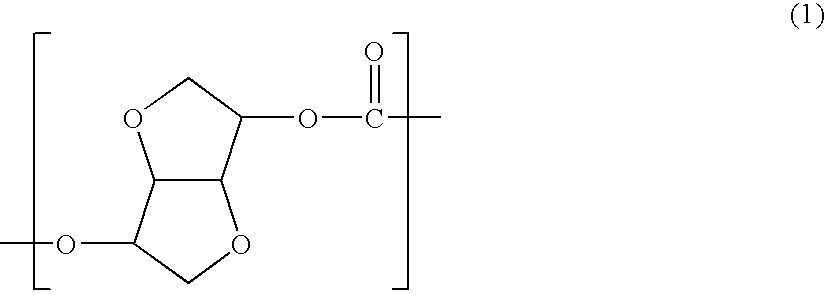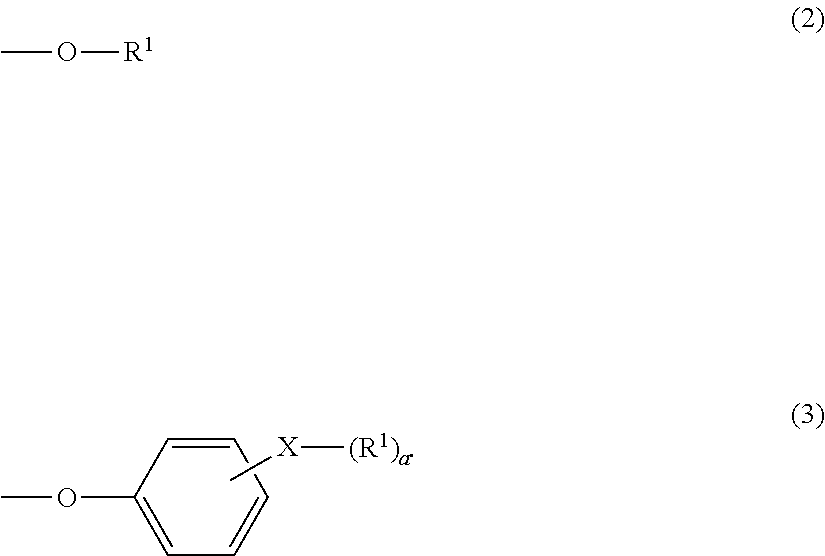Terminal modified polycarbonate and manufacturing process thereof
a technology of polycarbonate and terminal modification, applied in the field of terminal modification polycarbonate, can solve the problems of unsatisfactory moldability, difficult moldage, and inability to improve the melt viscosity, and achieve excellent heat resistance, moldability and moisture absorption resistance, and high surface energy.
- Summary
- Abstract
- Description
- Claims
- Application Information
AI Technical Summary
Benefits of technology
Problems solved by technology
Method used
Image
Examples
example 1
[0114]1,608 parts by weight (11 mols) of isosorbide, 2,403 parts by weight (11.22 mols) of diphenyl carbonate and 60 parts by weight (0.22 mol) of stearyl alcohol were fed to a reactor, and 1.0 part by weight (1×10−4 mol based on 1 mol of the diphenyl carbonate component) of tetramethylammonium hydroxide and 0.9×10−3 part by weight (0.2×10−6 mol based on 1 mol of the diphenyl carbonate component) of sodium hydroxide as polymerization catalysts were fed to the reactor and dissolved at 180° C. in a nitrogen atmosphere.
[0115]The inside pressure of the reactor was gradually reduced to 13.3×10−3 MPa over 30 minutes under agitation while the formed phenol was distilled off. After a reaction was carried out in this state for 20 minutes, the temperature was raised to 200° C., the pressure was gradually reduced to 4.00×10−3 MPa over 20 minutes to carry out the reaction for 20 minutes while the phenol was distilled off, and the temperature was further raised to 220° C. to carry out the reacti...
example 2
[0117]1,608 parts by weight (11 mols) of isosorbide and 89 parts by weight (0.33 mol) of stearyl alcohol were fed to a reactor equipped with a thermometer and a stirrer, the inside of the reactor was substituted by nitrogen, and 8,900 parts by weight of well dried pyridine and 32,700 parts by weight of methylene chloride were added to dissolve the above substances. 1,420 parts by weight (14.30 mols) of phosgene was blown for 100 minutes under agitation at 20° C. After the blowing of phosgene, stirring was carried out for about 20 minutes to terminate the reaction. The product after the end of the reaction was diluted with methylene chloride, pyridine was neutralized with hydrochloric acid to be removed, the obtained product was rinsed with water repeatedly until its conductivity became almost equal to that of ion exchange water, and methylene chloride was evaporated to obtain a powder. The obtained powder was melt extruded into a strand which was then cut to obtain a pellet. This pe...
example 3
[0118]Polymerization was carried out in the same manner as in Example 1 to obtain a pellet except that 1,608 parts by weight (11 mols) of isosorbide, 2,427 parts by weight (11.33 mols) of diphenyl carbonate and 134 parts by weight (0.44 mol) of 3-pentadecylphenol were used. The obtained pellet had a specific viscosity of 0.24 and a terminal modifying group content of 5.6 wt %. Other evaluation results of this pellet are shown in Table 1.
PUM
| Property | Measurement | Unit |
|---|---|---|
| contact angle | aaaaa | aaaaa |
| water absorption coefficient | aaaaa | aaaaa |
| wt % | aaaaa | aaaaa |
Abstract
Description
Claims
Application Information
 Login to View More
Login to View More - R&D
- Intellectual Property
- Life Sciences
- Materials
- Tech Scout
- Unparalleled Data Quality
- Higher Quality Content
- 60% Fewer Hallucinations
Browse by: Latest US Patents, China's latest patents, Technical Efficacy Thesaurus, Application Domain, Technology Topic, Popular Technical Reports.
© 2025 PatSnap. All rights reserved.Legal|Privacy policy|Modern Slavery Act Transparency Statement|Sitemap|About US| Contact US: help@patsnap.com



